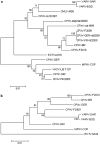Necrotic ulcerated lesion in a young boy caused by cowpox virus infection
- PMID: 22110431
- PMCID: PMC3219450
- DOI: 10.1159/000331426
Necrotic ulcerated lesion in a young boy caused by cowpox virus infection
Abstract
The case presented here points towards the fact that skin lesion observed with a cowpox virus is a rare event but should be considered more as the number of cases has increased in the last years. Cowpox virus (CPXV) belongs to the Poxviridae family. The transmission of CPXV to humans is caused by wild rodents or mostly by domestic animals and pet rats. In humans, CPXV is responsible for localized skin lesions regularly accompanied by lymphadenopathy. The lesions remain localized but self-inoculation from the primary lesions could occur. Then physicians have to be vigilant concerning bandages. In this case report, a necrotic and ulcerated lesion of a CPXV infection in a young boy is reported. The CPXV was possibly transmitted by wild rodents. The importance of performing the diagnosis is also pointed out. Virus information was obtained from phylogenetic analyses showing that the CPXV isolate was distinct from outbreaks of human cowpox which occurred in 2009 in France and Germany but was close to the CPXV Brighton Red strain. For several years, cases of viral zoonosis caused by CPXV have increased and physicians should be made aware that people could be infected without history of direct contact with animals.
Keywords: Cowpox virus; Diagnosis; Hemagglutinin gene; Necrotic; Orthopoxvirus; Rodent; Ulcerated lesion; Zoonosis.
Figures


References
Publication types
LinkOut - more resources
Full Text Sources

